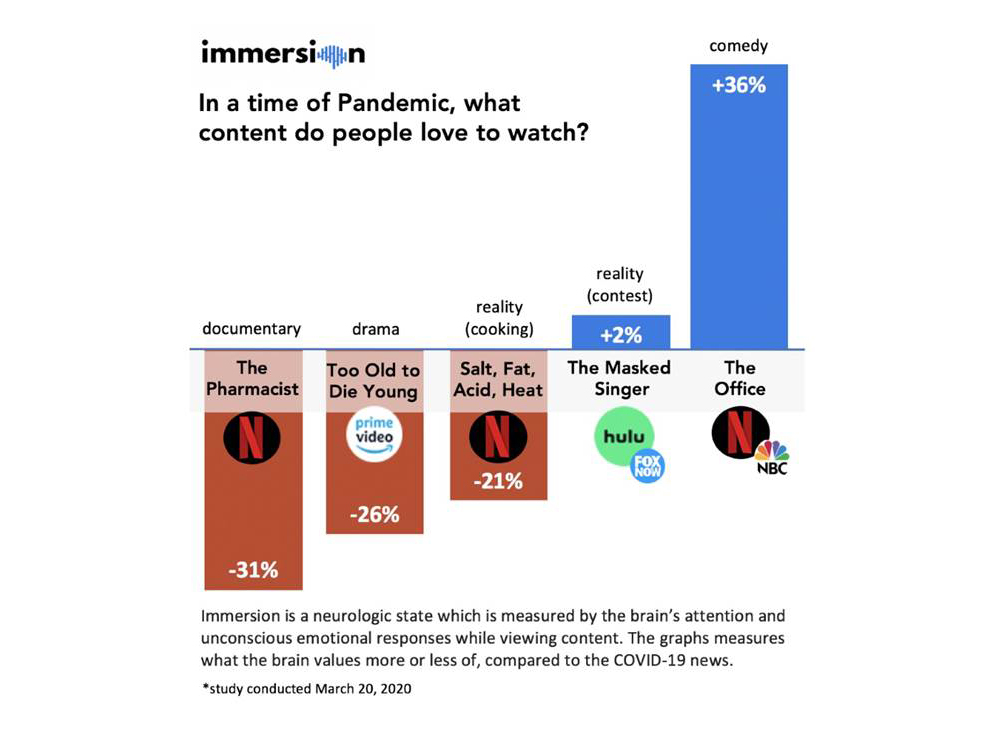In a Time of Pandemic, What Do People Want to Watch?

"To find out, we captured viewers’ neurologic immersion – a second-by-second measurement of what is most valued by the brain – while people watched some of the most popular shows on TV and streaming services." -Paul J. Zak, founder, Immersion Neuroscience
Quarantines. Shelter at home. Sickness. Death. These themes have taken over our lives in the era of COVID-19, from conversations with friends to the news we watch and the information we share online. It’s a lot like passing a car wreck – as hard as we may try, we just can’t look away.
In fact, most of us are glued to the news. In the past two weeks local news viewership has increased 11%, and cable news viewership has skyrocketed 73% from the same time last year. Of course, it should be expected that video consumption will go up as more people are confined to their homes. The new norm of self-isolation can be boring, lonesome and depressing, and there’s no better way to pass the time than binge watching our favorite shows. But besides the news, what else are people watching? Is all this doom and gloom really what our brains value the most?
Our company recently put this to the test, utilizing the latest advancements in neuroscience technology to assess what people's brains value in the age of the pandemic. Is it more COVID info? TV dramas? Comedies?
To find out, we captured viewers’ neurologic immersion – a second-by-second measurement of what is most valued by the brain – while people watched some of the most popular shows on TV and streaming services. Why neurologic immersion? By measuring people's brains using a small sensor worn on the arm – rather than asking them what they believe they like – we get a far more accurate response. All of our testing was completed remotely while dozens of participants relaxed in the comfort and safety their homes and captured in the cloud.
The programming we assessed ranged from singing competitions to popular comedies and dramas, as well as a network news story about COVID deaths for comparison.

To no surprise, news about COVID-19 generated high immersion in participants. We all want to stay up to date with the latest developments, right? But when participants watched the staff of Dunder Mifflin in the hit-TV sitcom, The Office, neurologic immersion was an astonishing 36% higher – producing by far the highest immersion response in our study. For comparison, The Masked Singer, Fox’s popular reality singing competition, was only marginally more immersive than the news, at 2% higher.
The smarter way to stay on top of broadcasting and cable industry. Sign up below
The other shows we tested were valued significantly lower by participants' brains, despite their popularity among critics and audiences. These included the Netflix cooking show Salt, Fat, Acid Heat (-21%), Amazon Prime’s drama Too Old to Die Young (-26%) and the Netflix documentary about opioid addiction The Pharmacist (-31%).
So, while news viewership is up, it's not actually what our brains are craving, despite what a viewer might tell you. The brain doesn’t lie, and what viewers’ brains want right now is something funny, familiar and easy to digest.
If you’re in the content business, consider giving the people what they really want in this time of pandemic. No, not a vaccine. What we need is the next Friends, Seinfeld or The Office. It might just be the key to saving our sanity until this crisis passes.
Immersion Neuroscience is an advanced predictive software company unlocking neuroscience to measure what people love.
